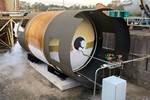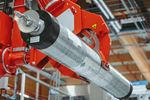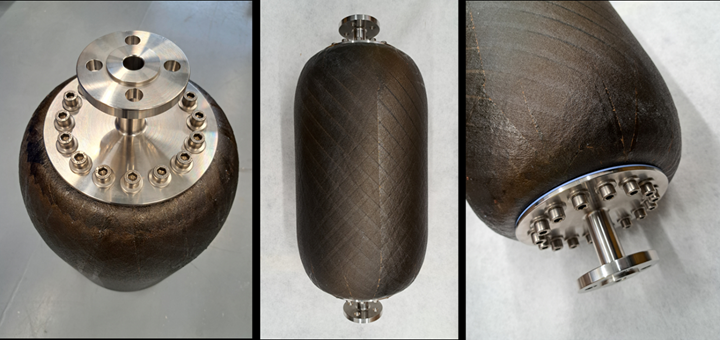NCC composite cryogenic tanks successfully tested with LH2
Thirty-liter single-piece and split-piece tank constructions underwent various pressures and test cycles while maintaining full integrity. End boss design testing is underway.
Share
Read Next
The National Composites Centre (Bristol, U.K.) has announced that it has successfully tested a range of composite cryogenic storage tanks with liquid hydrogen (LH2) that it has designed and manufactured. Considered one of the first composite cryogenic hydrogen storage tanks that has been designed, built and tested in the U.K., this forms part of the company’s journey in developing expertise in this area, to support the U.K.’s transition to the hydrogen economy.
The results build on previous announcements about NCC’s composite cryogenic storage tank testing program and concepting tools. Composites design expertise is critical to achieving long life cryogenic storage tanks, to overcome some of the potential limitations of composite material formulations. Commercial hydrogen aircraft will need fuel tanks to be as light as possible, filled and emptied numerous times (high cycle) and to last for several decades.
Undertaken with Filton Systems Engineering (FSE, Bristol), the tank-testing program used an LH2 vacuum test chamber and cryo-rated testing instrumentation. Tank performance was closely monitored throughout testing to compare performance against models, with the tanks successfully maintaining full integrity.
Two tanks were tested using LH2 — one a single-piece construction and the other a split-piece design — to assess viability for the design and manufacture of large tanks. The tanks were 30 liters in capacity, designed for a pressure of 8 bar, and manufactured using automated fiber placement (AFP) on-site at the NCC. The tanks comprised only a single skin to contain the LH2, and were mounted within a vacuum chamber at FSE’s test facility to provide insulation.
The one-piece tank was subject to 10 thermal cycles of being emptied and re-filled with LH2, up to a pressure of 1 bar, followed by a single pressure cycle up to 7 bar. The two-piece tank underwent 10 pressure cycles from 0-7 bar at LH2 (-253°C) temperature. The results have enabled model validation, with further cycling scheduled at FSE to test alternative end boss designs using the same composite tank.
“Our results and novel methods developed will enable rapid advancement within the U.K., building fundamental understanding of the challenges in designing and manufacturing cryogenic tanks,” Marcus Walls-Bruck, head of hydrogen technologies at the NCC, says. “This is a significant step forward in the U.K. goal to develop capability in designing and manufacturing hydrogen powered aircraft of the future.”
The NCC is also developing a state-of-the-art manufacturing and test facility for hydrogen transportation and storage, for pressure vessels and pipes, which will underpin its design, test and manufacturing capabilities. With a pressure test system already in place, a filament winder and thermoplastic pipe winder will be installed at the facility by the end of 2023.
For more information about accessing the NCC composite cryogenic tank testing, and concepting and design tools, email: hydrogen@nccuk.com
Related Content
-
Plant tour: Hexagon Purus, Kassel, Germany
Fully automated, Industry 4.0 line for hydrogen pressure vessels advances efficiency and versatility in small footprint for next-gen, sustainable composites production.
-
Braided thermoplastic composite H2 tanks with co-consolidated molded boss areas to fit EV battery space
BRYSON project demonstrates possible designs, automated manufacturing and low permeability concepts, including EVOH liner and novel PPA matrix.
-
Manufacturing tech for scalable Type V hydrogen tank fabrication, CFRP lifecycle management
Cygnet Texkimp’s Multi Roll Stack and composite recycling technology catalyze ASCEND program’s mission to optimize aerospace, automotive hydrogen storage and CFRP sustainability.

















